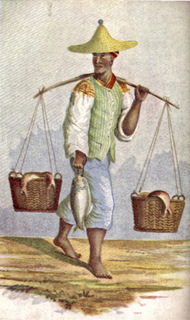.jpg) |
| Cape Pickled Fish |
But this dish, properly made with good, fresh ingredients, is quite delicious, and I urge you to give the recipe a bash.
Consisting of firm-fleshed white line fish soaked in a turmeric-yellow, oniony, lightly curried pickle, this dish has a long and noteworthy history as one of the classic staples of 'Cape Malay' cooking. The basic recipe has remained largely unchanged over at least two centuries; its pedigree is doubtless older than that, because the dish was bought to the Cape from the East during the earliest days of the slave trade.
There isn't space on this blog to do justice to the long and painful saga of slavery at the Cape, or to the culinary heritage of the descendants of slaves. If you're interested, do please visit the Cape Slavery Heritage blog, an encyclopaedic site packed with fascinating stories and many compelling images.
 |
| Cape Slave Fisherman. Image courtesy of Patric Tariq Mellét |
Hildagonda J. Duckitt, one of South Africa's most esteemed historical cookbook authors, provided a recipe for sole pickled with mango relish, onions, 12 small chillies and a full quart of vinegar in her famous Hilda's 'Where Is It?' Of Recipes (1891).
Although the key ingredients of this well-loved staple have remained unchanged over time, there are hundreds of different recipes: each family has its own particular favourite, often a closely guarded formula. In their brilliantly instructive book Cookery in Southern Africa: Traditional and Today (1970), Lesley Faull and Vida Heard give no fewer than four different recipes, of varying complexity, for 'ingelegde' [pickled] fish. Faldela Williams, author of the definitive reference The Cape Malay Cookbook (1988), remembers this recipe from her childhood in District Six as a festive dish, reserved for high days and holidays. Her recipe is a rather pared-down one, containing only nine pickling ingredients, while esteemed local foodie and wine writer Michael Olivier provides a more complex recipe for kerrievis [curried fish], containing 15 picking ingredients.
What all these recipes have in common is fish, onions, turmeric, salt, curry powder and the all-important vinegar. Important, of course, because this is the acidifying agent that prevents bacterial growth and preserves the fish. In older recipes for pickled fish, the fried fillets are packed into jars, liberally doused with a very vinegary pickling solution and set aside in a cool place to keep for many weeks, or even months.
I find most ready-bought pickled fish (which is available in many supermarkets and delis in Cape Town) too aggressively vinegary and oily, so here is my version, which uses just a little vinegar and oil, and several pungent lemony ingredients. This pickle will not, of course, last for months in a jar, but you can keep it in the fridge for four to five days. This is lovely with fresh brown bread and butter, and crisp finely sliced iceberg lettuce.
Extra-Lemony Cape-Malay-Style Pickled Fish
For the fish:
1 kg firm-fleshed white fish, skinned and thoroughly boned (I used sustainable yellowtail)
½ cup (125 ml) flour, for dusting
salt and white pepper
3 Tbsp (45 ml) vegetable oil
For the pickle:
4 Tbsp (60 ml) flavourless oil (sunflower or canola)
2 onions, peeled and sliced in rings (not too finely)
2 cloves garlic, peeled and finely chopped
a thumb-size piece of ginger, peeled and grated
4 bay leaves
6 fresh lemon leaves
3 whole white cardamom pods
1 tsp (5 ml) cumin seeds
1 large red chilli, deseeded and finely chopped
2 tsp (10 ml) turmeric
1 tsp (5 ml) mild curry powder
1 Tbsp (15 ml) brown sugar
4 Tbsp (60 ml) white wine vinegar
1 tsp (5 ml) finely grated lemon zest
8 black peppercorns
1 tsp (5 ml) salt
the juice of 3 lemons
½ cup (125 ml) water
To top:
extra fresh lemon leaves
Cut the fish into portions each about the size of a deck of cards. Put the flour onto a plate and season with salt and white pepper. Heat the oil over a brisk flame in a frying pan. Dust each slice of fish in the seasoned flour, shake to remove the excess, place in the hot oil and fry, in batches, for 2-3 minutes on each side, or until golden brown on both sides and just cooked through. Remove from the heat and set aside.
Now make the pickling mixture. Wipe the pan clean of oil and residue using a piece of kitchen paper. Heat the vegetable oil in the pan, over a medium-high flame. When the oil's good and hot, add the onion rings and fry for three minutes, or until they beginning to colour, but still retain a good crunch. Add the garlic, ginger, bay leaves, lemon leaves, cardamom and cumin seeds and cook, stirring gently, for another minute or two, taking care not to let the garlic brown.
Now add the chilli, turmeric, curry powder, sugar, vinegar, lemon zest, peppercorns and salt. Turn down the heat and bubble gently for two minutes, or until the mixture has reduced slightly, and the strong vinegary flavour has cooked away.
Stir in the lemon juice and water. Simmer for another minute, then remove from the heat.
Tip half of this mixture into the bottom of a ceramic or plastic dish just big enough to hold all the fish in a single layer. Pour the remaining mixture on top, making sure every piece of fish is well coated with the pickling liquid. Top with a few extra lemon leaves, cover the dish tightly with clingfilm or a lid, and refrigerate for at least 12 hours - preferably 24 - turning the fish now and then in its pickle. Serve cold, with buttered brown bread.
Makes 1 kg pickled fish



